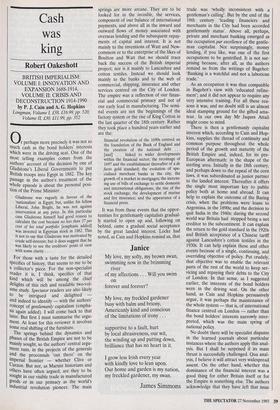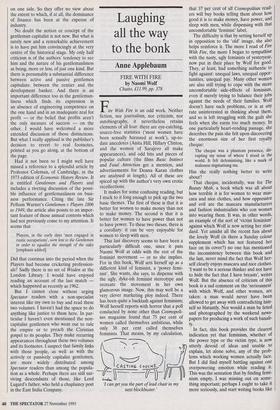Cash was king
Robert Oakeshott
BRITISH IMPERIALISM: VOLUME I: INNOVATION AND EXPANSION 1688-1914, VOLUME II: CRISIS AND DECONSTRUCTION 1914-1990 by P. J. Cain and A. G. Hopkins Longman, Volume I, £38, £16.99, pp. 520, Volume II, £30, £11.99, pp. 352 Or perhaps more precisely it was not so much cash as the bond holders' interests which were in the driving seat. One of the most telling examples comes from the authors' account of the decision by one of Gladstone's Liberal Governments to put British troops into Egypt in 1882. The key passage in the author's treatment of the whole episode is about the personal posi- tion of the Prime Minister: Gladstone was vaguely in favour of the `nationalists' in Egypt; but, unlike his fellow Liberal, John Bright, he was not against intervention at any price. In this particular case Gladstone himself had good reason to calculate the cost because no less than 37 per cent of his total portfolio [emphasis added] was invested in Egyptian stock in 1882. This is not to say that Gladstone was motivated by Crude self-interest; but it does suggest that he was likely to see the creditors' point of view with some clarity .. .
For those with a taste for the detailed specifics of history, that seems to me to be a collector's piece. For the non-specialist reader it is I think, specifics of that kind which will be among the chief delights of this rich and readable two-vol- ume study. Spectator readers are also likely to be intrigued and delighted and indeed to identify — with the authors' concept of gentlemanly capitalism (empha- sis again added). I will come back to that later. But first I must summarise the argu- ment. At least for this reviewer it involves some real shifting of the furniture.
The springs behind the dynamics and phases of the British Empire are not to be mainly sought, so the authors' central argu- ment runs, in the projects of the generals and the proconsuls 'out there' on the Imperial frontier — whether Clive or Curzon. But nor, as Marxist historians and others have often argued, are they to be sought in our visible trade in manufactured goods or in our primacy as the world's industrial revolution pioneer. The main
springs are more arcane. They are to be looked for in the invisible, the services, component of our balance of international payments, and above all in the inward and outward flows of money associated with overseas lending and the subsequent repay- ments of capital and interest. It is not mainly to the inventions of Watt and New- commem or to the enterprise of the likes of Boulton and Watt that we should trace back the success of the British imperial project; nor is it mainly to Lancashire and cotton textiles. Instead we should look mainly to the banks and to the web of commercial, shipping, insurance and other services centred on the City of London. The empire was a reflection of our finan- cial and commercial primacy and not of our early lead in manufacturing. The semi- nal events are not the beginnings of the factory system or the rise of King Cotton in the last quarter of the 18th century. Rather they took place a hundred years earlier and are the: financial revolution of the 1690s centred on the foundation of the Bank of England and the creation of the national debt .. . [and] . . . linked to wider developments within the financial sector; the recoinage of 1697 and the establishment thereafter of a de facto gold standard; the evolution of spe- cialised merchant banks in the city; the growth of a market in mortgages; the increas- ing use of bills of exchange to settle domestic and international obligations; the rise of the stock exchange; the development of marine and fire insurance; and the appearance of a financial press.
It was from these events that the oppor- tunities for gentlemanly capitalists gradual- ly started to open up and, following on behind, came a gradual social acceptance by the great landed interest. Locke had noted, as Cain and Hopkins remind us, that
trade was 'wholly inconsistent with a gentleman's calling'. But by the end of the 18th century 'leading financiers and merchants in the City had been accorded gentlemanly status'. Above all, perhaps, private and merchant banking emerged as the occupation par excellence of the gentle- man capitalist. Not surprisingly, money lending, if you like, was one of the first occupations to be gentrified. It is not sur- prising because, after all, as the authors remind us from the writings of Bagehot: `Banking is a watchful and not a laborious trade.'
As an occupation it was thus compatible in Bagehot's view with 'educated refine- ment'; and it did not appear to require any very intensive training. For all these rea- sons it was, and no doubt still is an almost ideal stamping ground for the gifted ama- teur. In our own day Mr Jaques Attali might come to mind.
There is then a gentlemanly capitalist interest which, according to Cain and Hop- kins, supplies the thread of continuity and common purpose throughout the whole period of the growth and maturity of the British Empire and, indeed, for its pre- European aftermath: in the shape of the sterling area. Initially in the 18th century, and perhaps down to the repeal of the corn laws, it was subordinated as junior partner to the landed interest. Thereafter it offers the single most important key to public policy both at home and abroad. It can help to explain the outcome of the Baring crisis, when the problems were loans to Argentina, in the 1890s; and the decision to quit India in the 1940s: during the second world war Britain had stopped being a net creditor to the subcontinent. It can explain the return to the gold standard in the 1920s and British acceptance of a Chinese tariff against Lancashire's cotton textiles in the 1930s. It can help explain these and other events because of a single, continuing, and overriding objective of policy. Put crudely, that objective was to enable the relevant parts of the rest of the world to keep ser- vicing and repaying their debts to the City of London. In that sense, as I suggested earlier, the interests of the bond holders were in the driving seat. On the other hand, as Cain and Hopkins persuasively argue, it was perhaps the maintenance of the whole system — that is, of international finance centred on London — rather than the bond holders' interests narrowly inter- preted, which was the, main spring of national policy.
No doubt there will be specialist disputes in the learned journals about particular instances where the authors apply this anal- ysis. But I shall be surprised if its main thrust is successfully challenged. Qua anal- ysis, I believe it will attract very widespread assent. On the other hand, whether this dominance of the financial interest was a good thing for either Britain itself or for the Empire is something else. The authors acknowledge that they have left that issue on one side. So they offer no view about the extent to which, if at all, the dominance of finance has been at the expense of industry.
No doubt the notion or concept of the gentleman capitalist is not new. But what is surely new and a remarkable achievement is to have put him convincingly at the very centre of the historical stage. My only half criticism is of the authors' tendency to see him and the nature of his gentlemanliness as being, more or less, of just one kind. But there is presumably a substantial difference between active and passive gentlemen capitalists: between the rentier and the development banker. And there is an important difference too in the gentleman liness which finds its expression in an absence of engineering competence on the one hand and in an inadequate zeal for profit — or the belief that profits aren't the only measure of success — on the other. I would have welcomed a more extended discussion of those distinctions. But what I really applaud is the publisher's decision to revert to real footnotes, printed as you go along, at the bottom of the page.
Had it not been so I might well have missed a reference to a splendid article by Professor Coleman, of Cambridge, in the 1973 edition of Economic History Review. It is entitled Gentlemen and Players and includes a riveting discussion of the possi- ble influence of gentlemanliness on busi- ness performance. Citing the late Sir Pelham Warner's Gentlemen v Players 1806 to 1949, the article also points to an impor- tant feature of those annual contests which had not previously come to my attention. It seems that
Players, in the early days 'men engaged in rustic occupations', were lent to the Gentlemen in order to equalise the strength of the sides [emphasis added].
Did that continue into the period when the Players had become cricketing profession- als? Sadly there is no set of Wisden at the London Library. I would have enjoyed reading an account of the last match which happened as recently as 1962.
But I cannot close without urging Spectator readers with a non-specialist interest like my own to buy and read these two volumes. I haven't had the space to do anything like justice to them here. In par- ticular I haven't even mentioned the non- capitalist gentlemen who went out to rule the empire or to preach the Christian gospel to its peoples. They make recurring appearances throughout these two volumes and its footnotes. I suspect that family links with those people, as well as with the actively or passively capitalist gentlemen, are more widely distributed among Spectator readers than among the popula- tion as a whole. Perhaps there are still sur- viving descendants of those, like Lord Lugard's father, who held a chaplaincy post in the East India Company.











































































 Previous page
Previous page